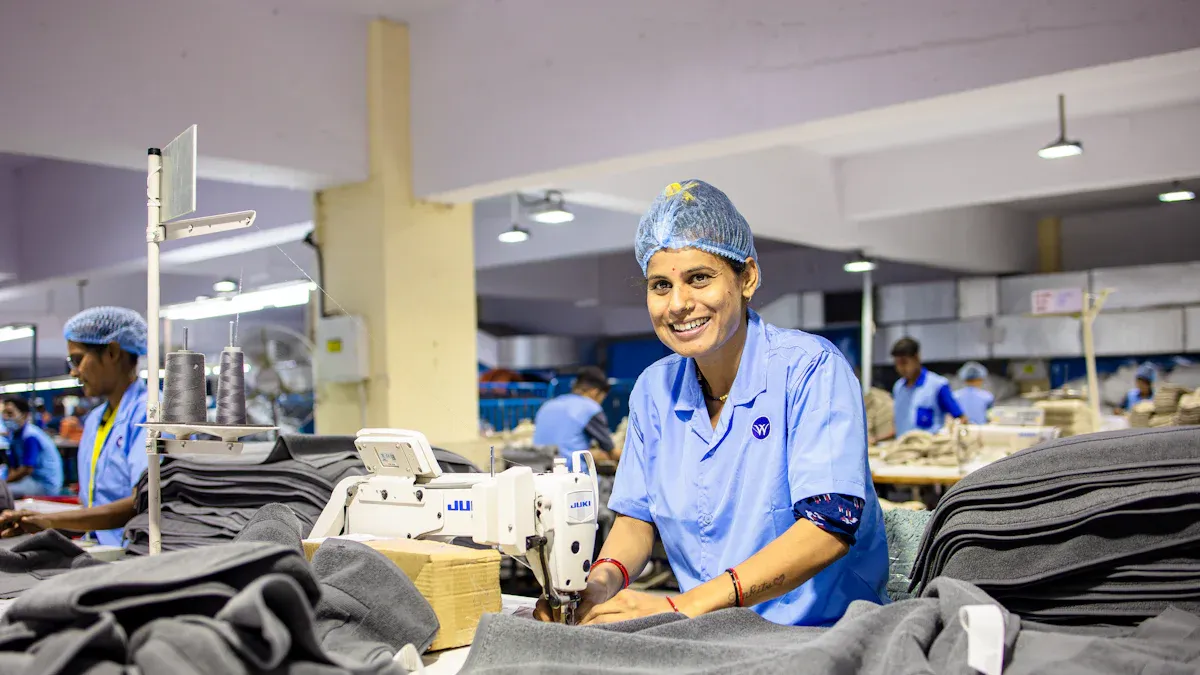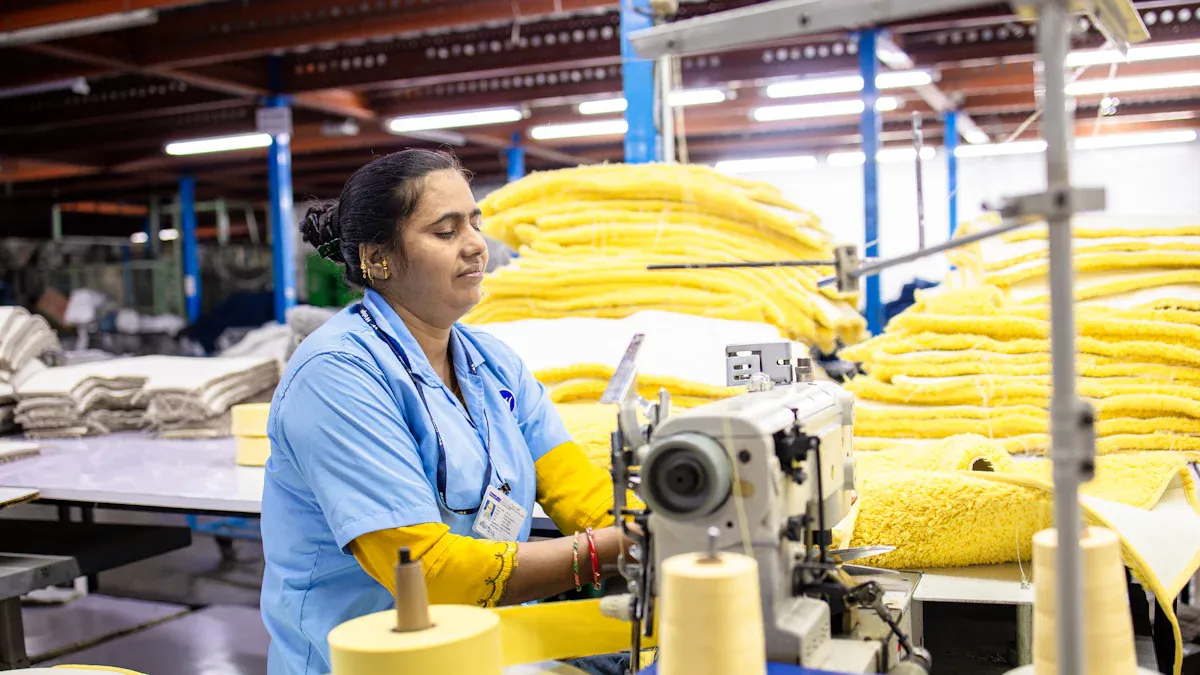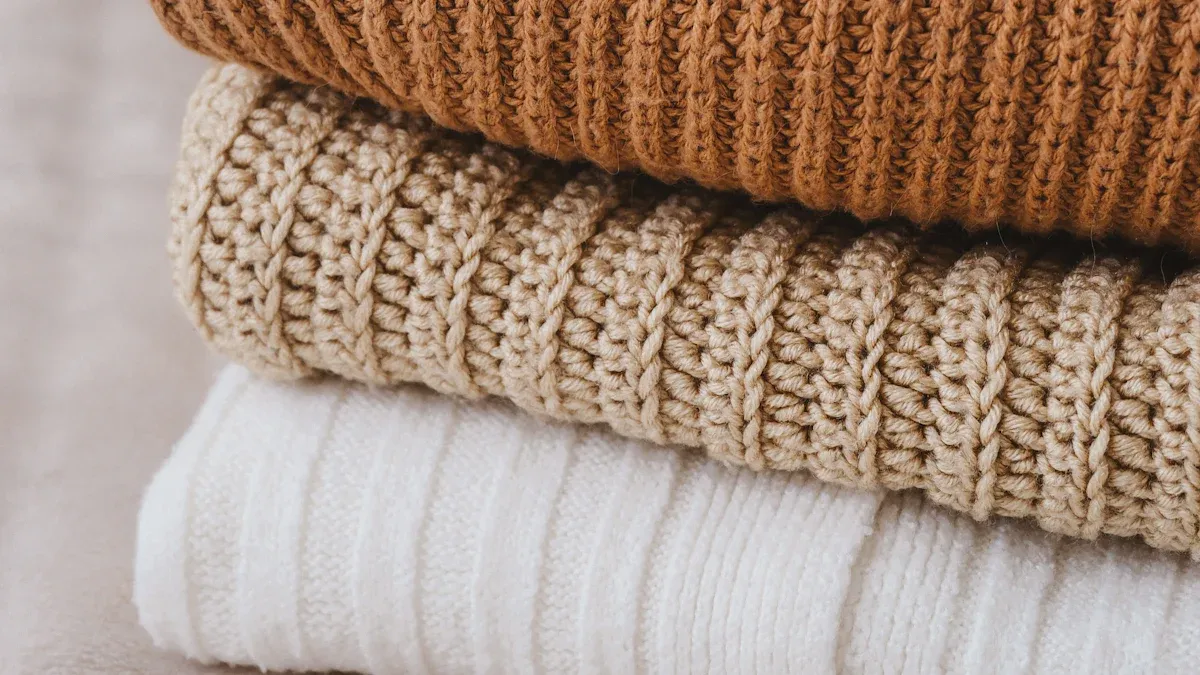
Sézane knitwear is produced in France, Italy, Portugal, and select locations in China. Most of the pieces come from small European workshops renowned for their craftsmanship and ethical work practices. As a Sézane knitwear manufacturer, the brand stands out for its commitment to sustainability. They carefully choose manufacturing sites based on skill and quality, using eco-friendly materials such as organic cotton and certified fibers. By limiting production quantities, they minimize waste. Sézane’s supply chain is transparent and regularly audited, reflecting their dedication to sustainable fashion.
Key Takeaways
Sézane makes most of its knitwear in Europe. They make it mostly in Portugal, Italy, and Turkey. Skilled workers and small workshops do the work.
The brand picks factories that follow strict rules. These rules are for fair work, safety, and quality. They check these factories often with outside audits.
Sézane uses eco-friendly materials like organic cotton. They also use recycled fibers. They do not use harmful animal products. This helps protect the planet.
The company shares supply chain details openly. They use QR codes and reports. This helps customers trust their ethical and green efforts.
Sézane focuses on slow fashion. They make fewer collections. They encourage people to reuse. They work to cut waste and lower harm to the environment.
Sézane Knitwear Manufacturer Locations

Europe
Sézane makes most of its knitwear in Europe. The brand works with small workshops and special factories. These places are in countries known for making good textiles. Portugal and Turkey help make denim and jersey items. Many knitwear pieces are made this way. Italy, Spain, and Portugal are important for making shoes. Sézane picks these countries because the workers have great skills. They also have a long history of making quality products.
About two-thirds of Sézane’s designs are made in Europe. These factories also make items for other luxury brands. By focusing on Europe, Sézane keeps quality high and follows good work rules.
Here is a table that shows the main European countries that help make Sézane knitwear:
Country | Production Details | Scale/Notes |
|---|---|---|
Portugal | Known for denim and jersey items (knitwear) | Makes up part of two-thirds of production |
Turkey | Known for denim and jersey items (knitwear) | Makes up part of two-thirds of production |
Italy | Shoes made here | European shoe production |
Spain | Shoes made here | European shoe production |
Portugal | Shoes made here | European shoe production |
China and Global Partners
Sézane also works with trusted partners outside Europe. The main factory in China makes some knits and all silk items. This factory has 62 full-time workers. It has worked with Sézane for over ten years. India is another place where some items are made. India is used for products that need special skills.
More than two-thirds of Sézane’s items are made in Europe. The rest, including some knitwear, comes from partners in China and India. Sézane picks these partners for their skill and high standards.
Selection Criteria
Sézane uses strict rules to pick a sézane knitwear manufacturer. The brand wants partners who give workers good conditions. They must also meet certification standards. Sézane checks this with visits or outside inspections. International groups help make sure factories follow safety and hygiene rules.
Sézane cares about being sustainable and ethical.
The brand likes partners with safe and fair workplace certificates.
Sézane works with factories that always make good products.
Sézane’s careful process makes sure every sézane knitwear manufacturer meets their rules for quality and ethics. This helps Sézane use both European and global partners with special skills.
Sézane Supply Chain Approach
Long-Term Partnerships
Sézane likes to work with the same partners for a long time. The brand uses many of the same ateliers and factories each year. This helps everyone trust each other. It also makes sure every item is made well. Sézane visits these partners often. They also have outside groups check the work. These checks help keep standards high. They also make sure everyone acts responsibly.
Sézane thinks strong partnerships help make better products and safer workplaces for all.
Quality and Ethics
Sézane’s supply chain cares about quality and doing the right thing. The brand picks materials that are better for the planet, like organic cotton. They do not use things like down, fur, angora, or exotic skins. Some wool comes from places that follow the Responsible Wool Standard. Sézane’s ateliers must follow strict rules. Outside groups check for fair pay, safe work, and no child or forced labor. These checks use rules like BSCI and SMETA. Some final steps have certificates from groups like the Ethical Trading Initiative and Fair Trade USA.
Sézane’s supply chain includes:
Regular checks for safe and legal work
Use of earth-friendly materials
Care for workers and animals
Sézane has made progress but still has things to fix. They need clear goals to cut greenhouse gas emissions. They also need to make sure all workers get a living wage.
Inventory and Collection Management
Sézane uses slow fashion ideas. The brand only makes four main collections each year. Small capsule collections add new choices but do not make extra waste. Sézane designs classic items that last a long time. This helps people buy less often. The brand also wants people to reuse and repurpose items. This plan keeps waste low and stops overproduction. Sézane uses renewable energy in its stores. This shows they care about a green future.
By choosing careful shopping, Sézane helps the planet and supports good choices.
Sustainable Fashion Initiatives

Materials and Certifications
Sézane is a leader in sustainable fashion. The brand picks eco-friendly materials and earns top certifications. Sézane uses these materials to help the planet. Their raw materials include organic cotton, natural fibers, and recycled things. These choices help make less waste and support circular practices.
Sézane is a Certified B Corp, which means it acts responsibly in fashion.
The brand uses FSC, GOTS, and OEKO-TEX® certifications to show it cares about materials.
Over two-thirds of Sézane’s items are made in Europe, with some made in India and Portugal.
Sézane uses recycled and natural fibers in many products.
These certifications and materials prove Sézane cares about the planet and circular fashion.
Environmental Practices
Sézane works hard to lower its impact on the environment. The brand uses natural and sustainable materials in its clothes. Some factories use renewable energy, and packaging is often recycled to cut waste. Sézane tries to lower its carbon footprint by using zero waste methods and supporting recycling.
Sézane has a repair program to help products last longer and support circular fashion.
The brand sets science-based goals to cut emissions and checks its progress.
Sézane uses less new plastic in packaging and picks recycled materials when it can.
The DEMAIN initiative helps with social and eco-friendly actions.
These green and circular steps help Sézane lead in sustainable fashion and recycling.
Ethical Labor
Sézane makes sure workers are treated fairly in its supply chain. The brand tracks parts of its knitwear supply chain and uses outside audits to check working conditions. Sézane’s suppliers follow rules like GOTS, SMETA, BSCI, and WCA. These checks make sure workers are safe, have fair hours, and get meal breaks.
Audit/Certification | Description |
|---|---|
BSCI | Checks if factories follow Sézane’s ethical code. |
SMETA | Checks working conditions and labor rules. |
ICS | Makes sure suppliers follow labor standards. |
WCA | Looks at workplace safety and work hours. |
B Corporation Status | Shows Sézane cares about social responsibility. |
GOTS | Checks for organic materials and fair trade labor. |
Sézane’s clothes are made in factories that are checked by audits like SMETA, BSCI, and WCA. These audits are done by outside groups to make sure workers have good conditions, fair hours, and meal breaks. Auditors check that workers get paid more than the local minimum wage, but this does not mean they always get a living wage. Sézane figures out living wage numbers on its own and is working to improve this.
Sézane’s focus on fair labor, green materials, and circular fashion shows its strong role in sustainable fashion.
Transparency and Challenges
Information Sharing
Sézane tells people about its supply chain in many ways. The brand puts QR codes on sweaters. These codes let you see where the wool comes from. You can even find out which farms in New Zealand made the wool. This helps shoppers learn about their clothes. Sézane also has a program called “La Liste.” This program shares the brand’s plans to use less waste and water. It also talks about using more renewable energy. Every year, Sézane checks its partners to make sure workers are treated well. They look for safe and healthy work places. Sézane also helps with the DEMAIN initiative. This uses money from special products to help children’s charities.
QR codes help track where wool comes from
“La Liste” shares goals for the environment
Suppliers are checked every year
DEMAIN helps children through charity
Sézane’s way of sharing information helps customers trust them. It shows they really care about being open.
Strengths
Sézane is good at telling people where things come from. The QR codes let buyers see where the materials start. The brand checks its partners every year to keep high standards. Sézane’s recycling program has taken care of over 13,000 clothes. This shows they work hard to lower their impact. The DEMAIN initiative links fashion with helping others. It brings good changes to communities.
Strength | Description |
|---|---|
Traceability | QR codes show where wool comes from |
Regular Audits | Partners are checked every year |
Recycling Program | Over 13,000 clothes recycled |
Philanthropy | DEMAIN gives to children’s charities |
Areas for Improvement
Sézane has done a lot, but there are still problems. The brand could tell more about all its factories, not just the main ones. It is not always clear how much workers are paid. Sézane could set public goals to cut greenhouse gas emissions. They could also use QR codes on more products. These changes would help make things even clearer. They would also help lower the impact of making clothes.
If Sézane works on these things, it can be even more open. It can keep leading in making fashion better for the world.
Sézane makes knitwear in Europe and some other places. They use certified materials and check their factories often. The brand is special because it is open about its process. Sézane cares about fair work and uses eco-friendly packaging.
Each item has icons that show if it uses sustainable materials or if the factory was checked.
Factories get checked every year, and Sézane tries not to make waste.
Benchmark | Sézane’s Approach |
|---|---|
Materials | |
Labor | Fair, audited, transparent |
Packaging | Recycled, reduced waste |
People trust brands like Sézane when they share how things are made and care about fair fashion.
FAQ
Where does Sézane make most of its knitwear?
Sézane makes most knitwear in Europe. Portugal, Italy, and Turkey have skilled workers and strong traditions in textiles. Some items come from trusted partners in China and India.
How does Sézane ensure fair working conditions?
Sézane checks factories every year. Outside groups like BSCI and SMETA visit and inspect. These checks help keep workers safe and treated fairly.
What materials does Sézane use for knitwear?
Sézane uses organic cotton, recycled fibers, and certified wool. The brand avoids fur, angora, and exotic skins. Many items have certifications like GOTS or OEKO-TEX®.
How can shoppers learn about Sézane’s supply chain?
Shoppers can scan QR codes on some sweaters. These codes show where the wool comes from. Sézane also shares supply chain details on its website and in “La Liste.”









